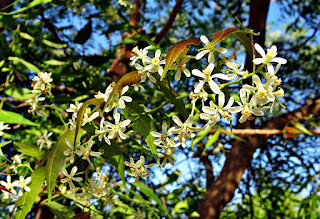 |
| Neem flowers Image courtesy: Bishnu Sarangi |
Kingdom : Plantae
Order : Sapindales
Family : Meliaceae
Genus : Azadirachta
Species : indica
Binomial name : Azadirachta indica A. Juss.
It is habitated in south-east Asia and tropical regions of Australia and Africa.
Neem is an evergreen tree, 10-20 m high with a straight trunk and long spreading branches. Leaves are alternate and exstipulate. Leaflets are alternate or opposite. The petioles are short. The flowers are white and fragrant. The fruit is an ovoid, smooth drupe, green when young, yellow to brown when mature with a very scanty pulp and a hardy endocarp. The seed is solitary with a thick testa and embryo with foliaceous cotyledons in the axis of the scanty endosperm.
- Neem oil is stimulant and antiseptic which is used in rheumatism and skin diseases. It is also used in the manufacture of oleic acid stearic acids.
- The leaves are used as an insect repellent, anti-viral and anti-fungal. The paste of leaves is used externally in cases of smallpox.

No comments:
Post a Comment